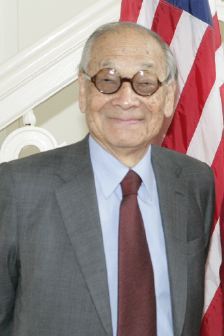Ieoh Ming Pei was born on April 26, 1917 in China.
26 April 1917 - 1919
Ieoh Ming Pei

description
An outstanding Chinese architect. His architecture reflects the desire to develop the theme of geometric expressionism, to boldly operate with hypertrophied large-scale stereometric volumes; he was looking for absolutes of meaningful form in the outlines of elementary geometric bodies. Ieoh Ming Pei, known for his deep understanding of the time, purpose and place of each of his creations, was interested in how a building will affect the life of the community that uses it. His quest sparked new design movements towards ergonomic design, sustainable living and construction.
Ieoh Ming Pei’s style characteristics:
- Pei was a member of the modernist generation, but opposed the consequences of globalization. Instead of creating globally homogeneous structures, he advocated the development and change of style based on the locality and the purpose of the project, seeking inspiration in Chinese traditions;
- Continuation of the aesthetics of Mies van der Rohe.
- Bold handling of large-scale stereometric volumes;
- Straight-line elementary geometric shapes;
- Light, tight flat surfaces, devoid of ornament and decor;
- Open interior spaces;
- Feeling of visual weightlessness;
- His favorite materials were glass and steel with a combination of less visible reinforced concrete.
Ieoh Ming Pei’s main buildings:
1) Place Ville-Marie (1962), Canada, (Montreal);
2) Everson Art Museum (1968), USA (Syracuse);
3) Paul Mellon Arts Center (1973), USA, (Wallingford);
4) National Gallery of Art. East Wing (1978), USA, (Washington);
5) Tower Bank of China (1989), Hong Kong.
6) John F. Kennedy Library (1991), USA, (Boston);
7) The Louvre Pyramid (1993), France, (Paris);
8) Rock and Roll Hall of Fame and Museum (1995), USA (Cleveland);
9) Museum of Contemporary Art of the Grand Duke Jean (MUDAM) (2006), Luxembourg (Luxembourg);
10) Park Pavilion in Wiltshire (2004), UK;
11) Suzhou Museum (2006), China (Suzhou);
12) Office of the Embassy of the People’s Republic of China (2008), USA (Washington);
13) Museum of Islamic Art (2008), Qatar (Doha).
Tower of the bank of China (1992) is one of the most famous skyscrapers in Hong Kong and has a cosmopolitan character. The height of the building with antennas is 367 meters. 72 storey building. The house has 2 observation platforms, one is located on the 43rd floor and is open to all comers, the other is located on the 70th floor. The structure also has a hidden metaphor. The project does not use explicit Chinese motives, but uses two important symbolic ideas. A two-ton granite pedestal is a symbol of stability and indestructibility, and bamboo shoots, as the main idea adopted in the design of this house, symbolizes life and prosperity. The entire structure is supported by five steel columns at the corners of the building, which are covered with a glass wall.
Pyramid in the courtyard of the Louvre, France, Paris, 1993 – the most famous project of the architect. The pyramid decorates the lobby of a huge art complex, united by underground structures. As the main entrance, the architect did not want to see something like a metro station, but an entrance that would attract visitors to the museum. Therefore, he proposed a more daring project, using the basic compositional principles and aesthetics of modernism. So he came up with the idea of a pyramid, which was later brought to life. It is 22 meters high, based on a 35 meter base. The pyramid is in stark contrast to the historic facades of Paris. The Louvre pyramid is now considered an iconic symbol of the French capital.
The Museum of Islamic Art in Doha (2008), inspired by ancient Islamic architecture, in particular the Ibn Tulun Mosque in Cairo, is located on a separate island and surrounded by a park. Both the exterior and interior, including the surrounding park, combine modern aesthetics with traditional symmetry of Islamic geometric designs to create a seamless transition between natural surroundings and spaces.
1917
1935
1955
1983
2019
Birth of the architect
Began to study architecture in the United States
Began to study architecture in the United States. He received his bachelor’s degree from the Massachusetts Institute of Technology and his master’s degree from Harvard.
Created his own architectural firm
Created his own architectural firm.
Won the Pritzker Prize
Won the Pritzker Prize.
The architect died
The architect died
